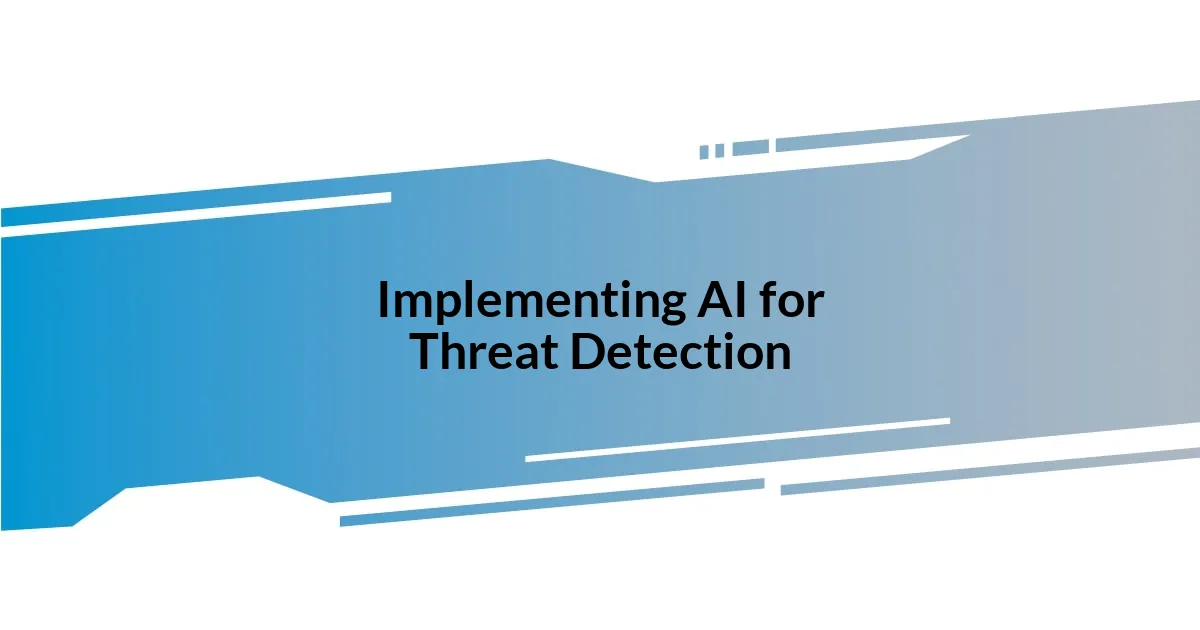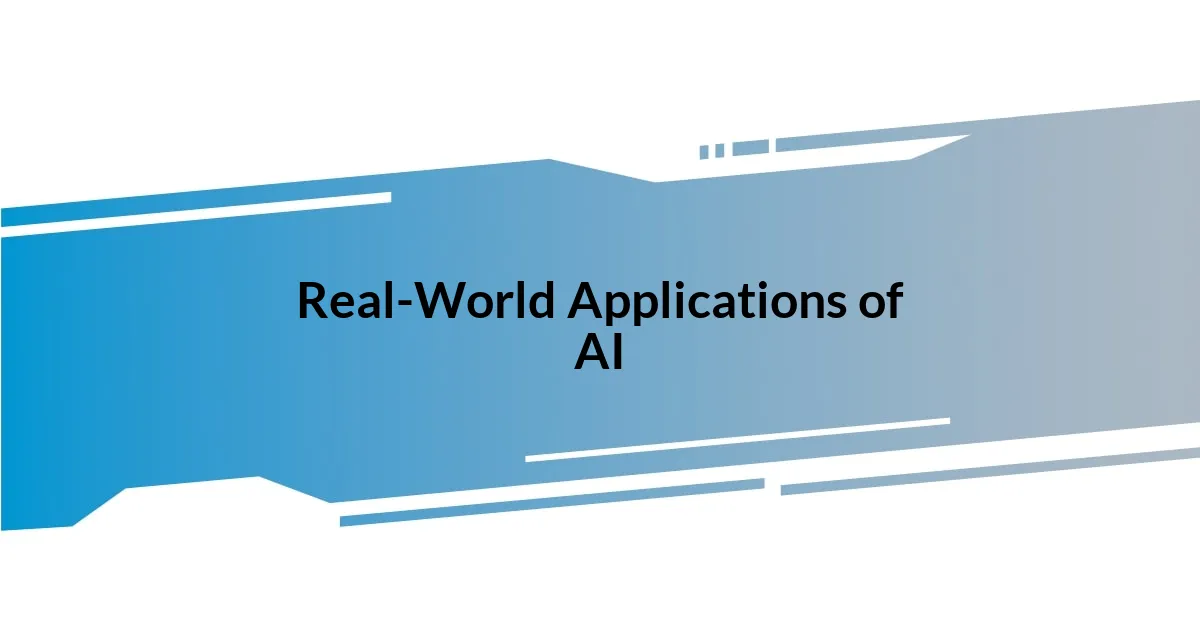Key takeaways:
- The threat detection process involves data collection, analysis through algorithms for anomaly detection, and timely alerts for incident response.
- Choosing AI tools requires a clear understanding of specific security needs, tool functionalities, and the importance of user experience.
- Implementing AI in threat detection transforms security from reactive to proactive, emphasizing data quality, team training, and continuous monitoring.
- Challenges in AI integration include team resistance, data privacy concerns, and technical difficulties, highlighting the need for trust and adaptability.

Understanding Threat Detection Processes
The threat detection process starts with data collection, where systems gather vast amounts of information from various sources. I can remember the first time I witnessed this firsthand; it felt like standing in the middle of a bustling city, trying to make sense of the endless flow of people. Isn’t it fascinating how every piece of data, like an individual passerby, holds the potential for revealing patterns of malicious behavior?
Once the data is in, it undergoes analysis through algorithms that identify anomalies. I often think about how these algorithms act like detectives, sifting through mountains of evidence to spot the irregularities that we, as humans, might overlook. Have you ever considered how different this is from human intuition, which can be clouded by emotions?
Finally, the results of this analysis prompt alerts, allowing teams to respond swiftly to potential threats. During my experience with incident response, I felt the rush of urgency as we acted to neutralize a threat. It’s a gripping moment, where technology and instinct blend, underscoring the critical role of AI in enhancing our vigilance. In what ways do you think we can further refine our detection processes to stay ahead of evolving threats?

Choosing the Right AI Tools
Choosing the right AI tools can feel overwhelming, especially with so many options available. I remember the days of evaluating different platforms, weighing their features like a chef considers ingredients for a perfect dish. Each tool brings something unique, and the right choice often hinges on understanding the specific needs of your security environment. Have you ever faced a similar dilemma in selecting a tool that fits just right?
Consider the diverse functionalities of AI tools; some excel in real-time threat detection while others specialize in predictive analytics. It’s essential to perform a side-by-side comparison of these capabilities, reflecting on past experiences to determine what worked well for your organization. I once chose a tool primarily for its speed but quickly discovered that depth of analysis was much more critical. This lesson taught me the importance of aligning tool features with the real-world challenges I faced.
As you navigate this landscape, remember to look at the user interface and the learning curve associated with the tools. Sometimes, a tool that seems powerful on paper can be frustrating to use, similar to a complex recipe that requires advanced skills. I’ve encountered tools that looked impressive but ultimately caused more headaches than solutions. In choosing wisely, think not just about immediate needs but also about long-term adaptability for future threats.
| AI Tool | Primary Function |
|---|---|
| Tool A | Real-time Threat Detection |
| Tool B | Predictive Analytics |
| Tool C | Incident Response Automation |
| Tool D | Data Visualization |

Implementing AI for Threat Detection
Implementing AI for threat detection is more than just deploying software; it’s about integrating technology into the core of our security processes. I vividly recall the moment we first integrated a machine learning model into our system. It was like flipping a switch—a light illuminating areas in our network previously obscured. Embracing AI meant redefining our approach to security from reactive to proactive.
Here’s what I learned during the implementation phase:
- Define Clear Objectives: Establish what you want to achieve—whether it’s reducing response time or identifying threats earlier.
- Data Quality Matters: Invest time in cleaning and aggregating your data; garbage in, garbage out, as they say.
- Team Training: Ensure your team knows how to leverage AI tools effectively; I’ve seen firsthand how knowledge gaps can hinder performance.
- Continuous Monitoring: AI systems require regular assessment to tune their algorithms for evolving threats; think of it like regular check-ups for your security health.
- Feedback Loops: Create mechanisms for teams to provide insights back to the AI systems, helping them learn and improve over time.
As we moved forward with our implementation, I felt a surge of optimism. Each small victory bolstered our team’s confidence, proving that AI isn’t just a gimmick; it’s a game-changer in identifying threats and fortifying our defenses. Have you ever experienced that thrill of watching technology not just perform but excel beyond expectations?

Real-World Applications of AI
AI’s real-world applications extend far beyond what many might initially think, particularly in the realm of threat detection. I once witnessed how AI dramatically transformed the way a financial institution managed fraud. By analyzing patterns in transaction data, the system identified anomalies and flagged potential fraudulent behavior almost instantaneously. It was fascinating to see how something that once took hours of manual review could now be accomplished in seconds, significantly reducing the risk of financial loss.
In a different setting, I experienced firsthand the power of AI in cybersecurity. During a routine security assessment, I was amazed to observe how an AI tool processed vast streams of network data, correlating events in real-time to detect threats. It felt like having a keen-eyed detective on the case, tirelessly scanning for signs of intrusion. This proactive monitoring not only helped us catch potential breaches early but also provided invaluable insights that informed our security strategy.
I’ve also come to appreciate AI’s role in automating incident response. One day, our team received alerts about a suspected malware infection. Instead of scrambling to gather information and deploy remedies, the AI system engineered an immediate response. It isolated the affected machines and initiated predefined mitigation actions. This experience made me reflect: how much would our stress levels decrease if AI handled the critical early steps in threat management? In leveraging AI, we are not only enhancing our defenses but also fostering a culture of confidence and resilience within our teams.

Challenges in AI Integration
Integrating AI into our threat detection systems came with its own set of hurdles. One challenge I remember vividly was the resistance from team members who were skeptical about the new technology. It’s disheartening when you’re excited about innovation, but those around you are clinging to the familiar. I learned that addressing this resistance isn’t just about proving that AI works; it’s about cultivating trust and demonstrating how it can make their jobs easier.
Another significant challenge was grappling with data privacy and ethical considerations surrounding AI. Different stakeholders had varying opinions on how data was being used. In one of our team meetings, debates got heated over compliance issues versus the necessity for broader data access. How do we strike the right balance? I found that fostering open conversations around these topics not only eased concerns but also encouraged a sense of collective accountability in our AI journey.
Additionally, I encountered the technical difficulties that arise when trying to integrate AI with existing systems. There was a day when a critical software update caused our AI models to falter, leading to missed alerts that could have been detrimental. That moment was a wake-up call. It made me realize the importance of thorough testing and having contingency plans in place. How often do we assume everything will work seamlessly? These instances taught me that vigilance and adaptability are indispensable when merging advanced technology with established practices.